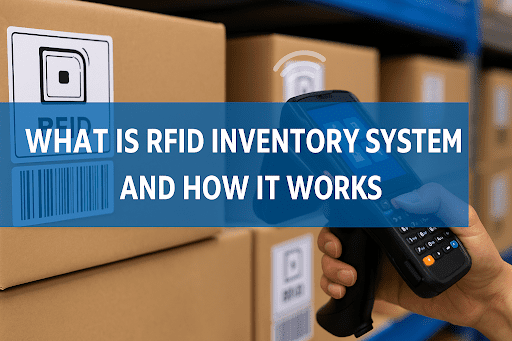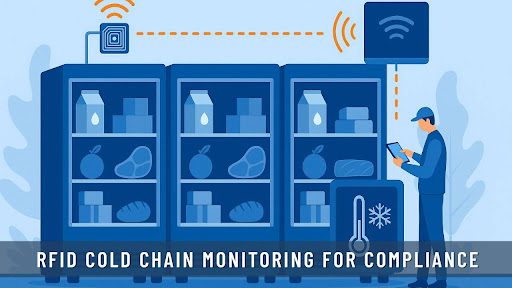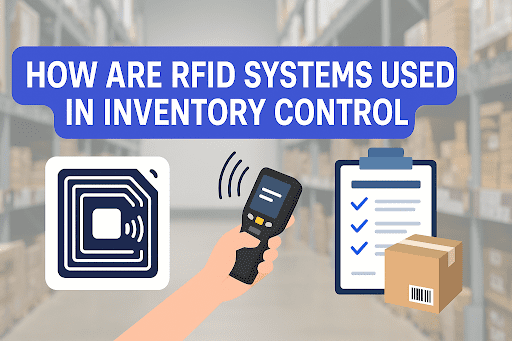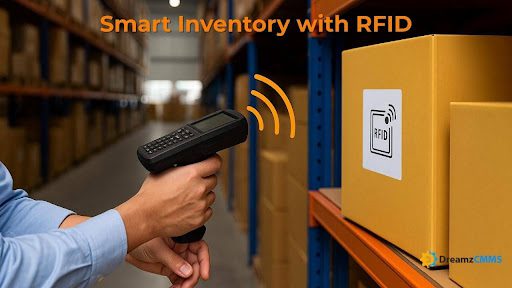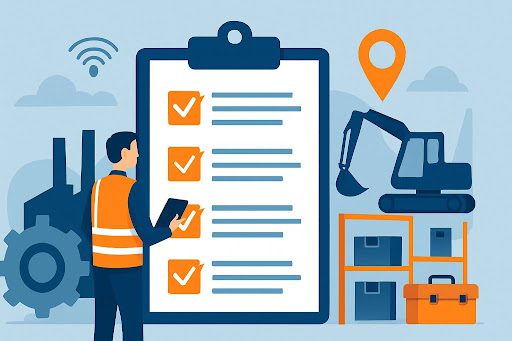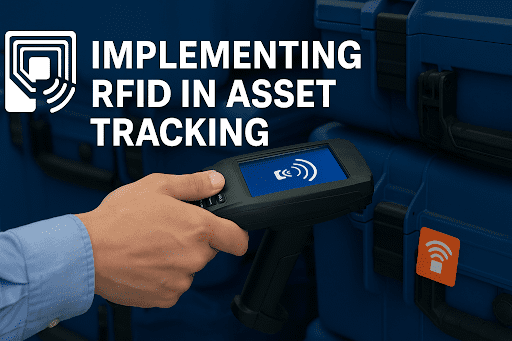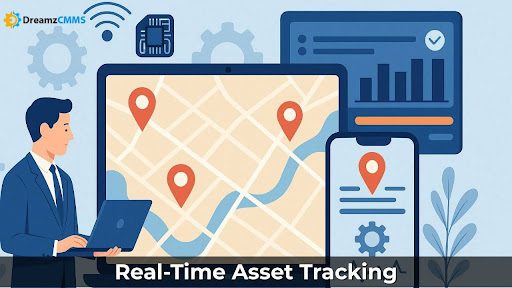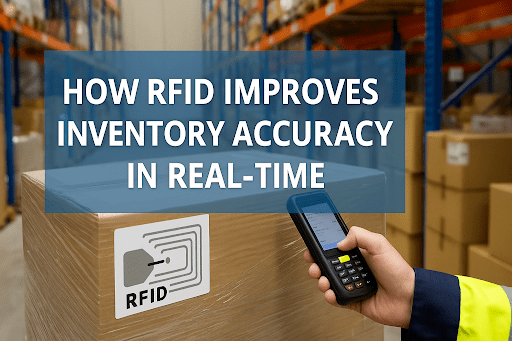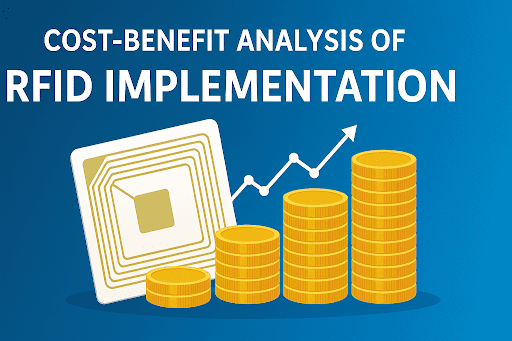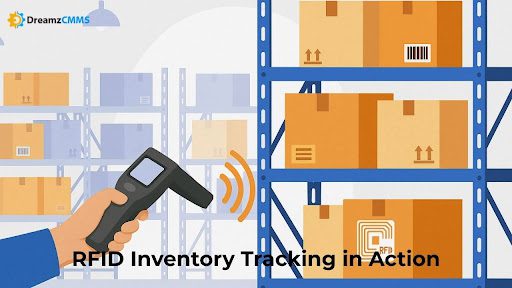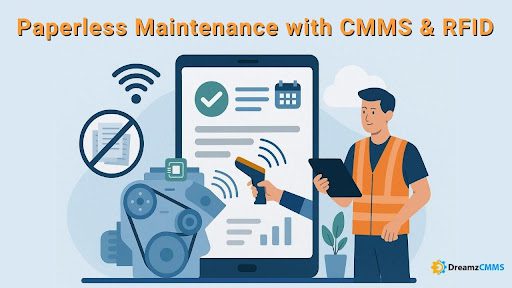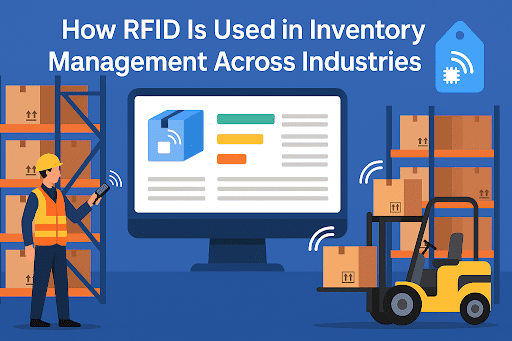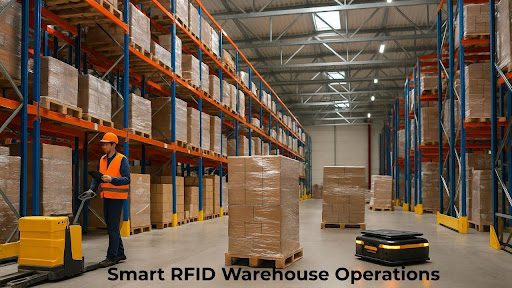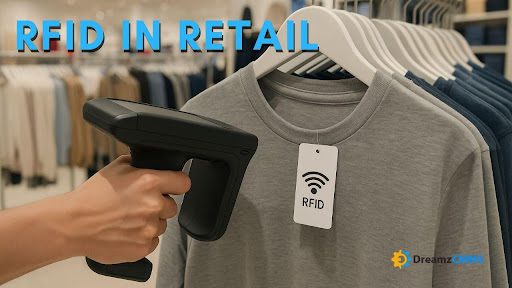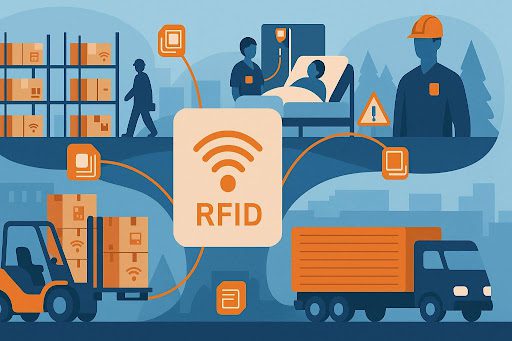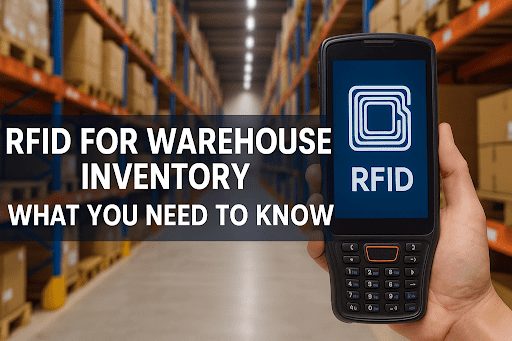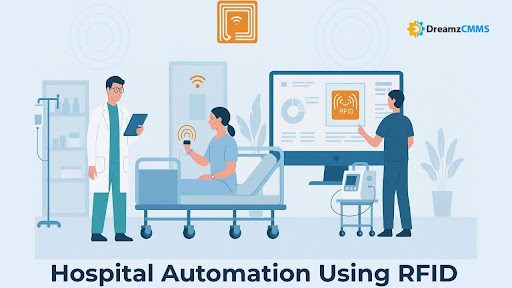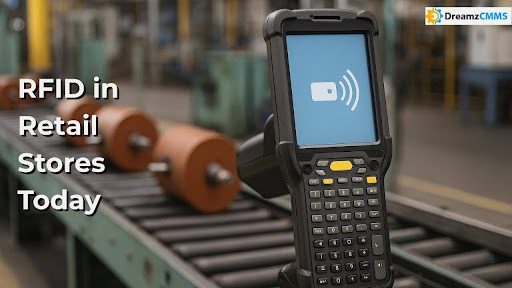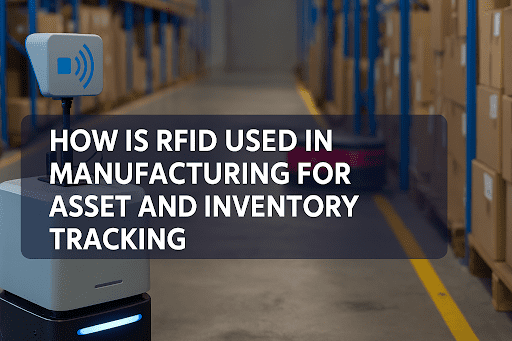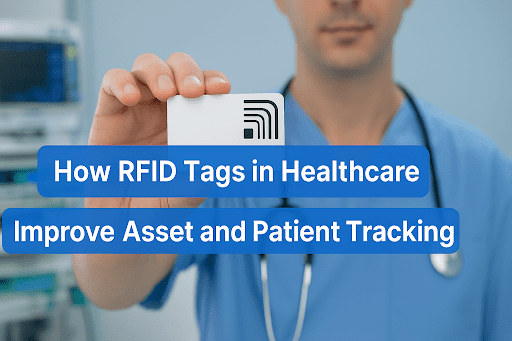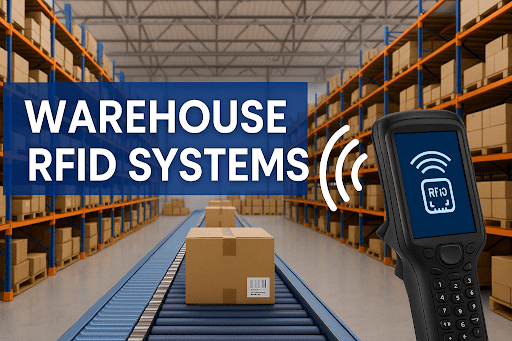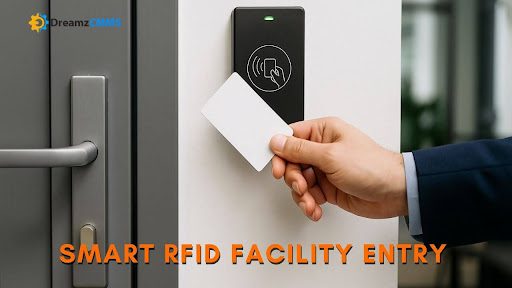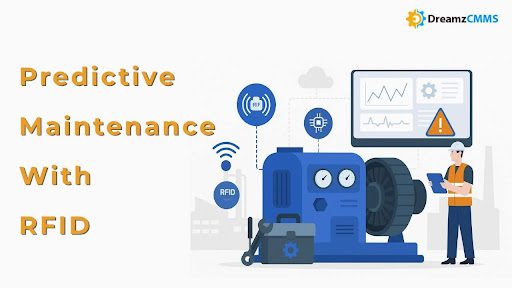 BACK TO Blog
BACK TO Blog
Asset Rental Management
RFID Asset Tracking
A well-run inventory management system stands as the fundamental requirement for operational efficiency. Various organizations in retail and logistics as well as healthcare and manufacturing need exact real-time tracking of their inventory. The combination of barcode scanning and manual logging systems frequently results in time-consuming processes with multiple mistakes together
- August 12, 2025
- DreamzCMMS Team
- 10 minutes read
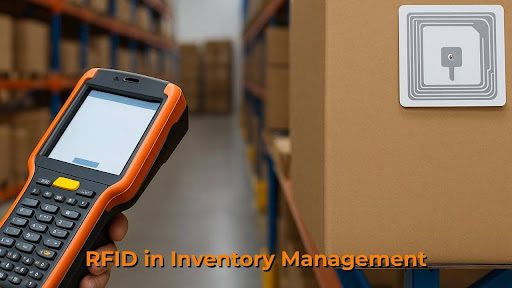
- August 12, 2025
- DreamzCMMS Team
- 10 minutes read
A well-run inventory management system stands as the fundamental requirement for operational efficiency. Various organizations in retail and logistics as well as healthcare and manufacturing need exact real-time tracking of their inventory. The combination of barcode scanning and manual logging systems frequently results in time-consuming processes with multiple mistakes together with unobservable gaps.
The implementation of RFID transforms current tracking operations. The ability to track assets without visual contact and quick multiple item scans makes RFID offer superior automation and precise tracking and complete control.
Total Control with Asset Maintenance Management SoftwareManaging assets alongside inventory? DreamzCMMS has you covered.With Asset Maintenance Management Software, you can:
|
What Is RFID and How It Works
The main advantage of RFID technology over barcodes lies in its ability to automatically scan multiple items without requiring direct visual contact so it revolutionizes inventory management operations.
The core operation of RFID depends on radio wave data transmission between reader devices and RFID tags which tag items. The system detects asset positions and conditions and records their movements automatically without manual input.
A standard RFID inventory tracking system requires several components for operation.
RFID Tags
Each small electronic RFID device stores a unique identification number and functions as an identifier for products and bins and equipment and pallets. The selection of RFID tags depends on the range along with cost requirements and specific use requirements.
- Passive RFID Tags:
The majority of inventory operations employ these tags. The tags operate without internal power because they need the electromagnetic signals from readers to activate.
Advantages: Lightweight, cost-effective, ideal for item-level or shelf-level tracking.
Best For: Retail inventory, warehouse bins, or consumables.
- Active RFID Tags:
The built-in battery of active tags enables them to continuously send signals to readers. The extended tracking range reaches 100 meters when using these tags for high-value and mobile asset applications.
Advantages: Long-range tracking (up to 100 meters), suitable for high-value or mobile assets.
Best For: Vehicles, containers, construction equipment, or fleet assets.
RFID tag inventory tracking benefits from different tag types which serve to track assets at various levels of detail based on the required scope of coverage.
RFID Readers
These devices are responsible for picking up the signals transmitted by the RFID tags. The system can be customized with different reader types based on your operational environment:
- Handheld RFID Readers:
These portable scanning devices serve best for inventory checks and audits as well as spot checks across different locations.
The devices work well in retail backrooms and stockrooms and service vehicles to provide scanning flexibility.
- Fixed RFID Readers:
These components should be installed at critical locations including warehouse shelves and production lines together with entry and exit points and loading docks.
Enable automated tracking of stock movement in and out of storage zones without manual input.
These readers help your system perform real-time inventory tracking by automating data acquisition so you don't need to scan every item individually. RFID inventory automation becomes possible through this system.
RFID Antennas
The connection between RFID tags and readers is achieved through antennas which act as a link. The RFID system needs antennas to generate radio signals that activate passive tags and to detect signals returned from both passive and active tags. Tag detection accuracy depends on how antennas are positioned as well as their operational range.
The system combines ERP or CMMS with RFID inventory integration through RFID Software to provide dashboards alongside analytics. The following section provides a detailed explanation of what RFID asset tracking is.
RFID Inventory Software
All collected data flows into an RFID inventory management platform or integrated CMMS with RFID inventory integration. The software performs key functions such as:
- Displaying real-time inventory levels and locations
- The system generates warnings for low stock levels and misplaced items and slow-moving products.
- The RFID system integrates RFID data with maintenance schedules while linking to procurement workflows and supplier dashboards.
Advanced platforms like DreamzCMMS RFID Asset Tracking Software also offer powerful analytics, reports, and integrations with ERP systems—making it easy to manage thousands of tagged items effortlessly.
Core Benefits: How RFID Helps in Inventory Management
1. Real-Time Inventory Visibility with RFID
1. Real-Time Inventory Visibility with RFID
The main advantage RFID brings to inventory management through real-time visibility stands out as the greatest benefit. When RFID readers monitor warehouse and supply chain and retail floor movement of goods they simultaneously record both location and status data.
The real-time inventory management system enabled by RFID allows businesses to:
- Current stock levels are available at any time.
- The system helps organizations prevent both excessive and insufficient inventory quantities.
- Faster replenishment choices can be made.
The organization benefits from streamlined operations that result in improved customer satisfaction.
2. Improve Inventory Accuracy with RFID
Manual counts are error-prone. Barcodes help but still require human effort and line-of-sight. RFID enhances accuracy through its ability to:
- The system prevents duplicate records while also preventing skipped scans from occurring.
- The system detects all products in each batch at a single moment.
- The stock levels receive automated updates.
The accuracy rate reaches above 99% due to this system allowing companies to decrease their write-offs and delays and customer frustration.
3. Inventory Automation Using RFID
RFID technology enables complete inventory automation through RFID which cuts both labor expenses and cycle time. Examples include:
- Auto-counting during goods receipt
- Automated cycle counts without stopping operations
- The system sends automatic alerts when inventory quantities reach specific thresholds.
Automated operations create enhanced productivity which allows staff members to handle essential tasks.
For deeper insights, read our guide on implementing RFID in asset tracking.
4. RFID for Stock Movement Tracking
The understanding of item movement throughout your operational processes serves as a fundamental requirement. RFID stock movement systems record all transitions in real time.
- From receiving to shelves
- Between storage zones
- During picking, packing, and shipping
RFID-based stock control offers deep analysis of both process constraints and product holding durations.
5. RFID for Supply Chain Visibility
RFID functionality reaches past traditional warehouse boundaries. Supply chain transparency enhances through RFID when applied to vendors and transport and distribution centers.
For example:
- Track deliveries in transit
- Validate outbound shipments
- Monitor third-party warehouse inventory
RFID supply chain visibility tracks inventory positions to prevent delays and misplacements.
RFID vs Barcode Inventory Tracking: A Quick Comparison
| Feature | RFID | Barcode |
| Scan Multiple Items | Yes | No |
| Line-of-Sight Required | No | Yes |
| Automation | High | Low |
| Accuracy | ~99% | Lower |
| Read Range | Up to 100m | Few cm |
| Cost | Higher upfront | Lower upfront |
The comparison between RFID and barcode inventory tracking systems shows that RFID offers superior long-term benefits to businesses seeking automation with precise tracking methods.
The assessment of investment value is available through a complete cost-benefit analysis of RFID implementation.
Inventory Optimization Using RFID: Going Beyond Basics
When RFID systems track items in real-time they generate their most important value through data analysis with analytics tools and inventory planning software.
The RFID system tracks all inventory movements automatically through all storage areas of receiving and picking and shipping zones. The continuous supply of location and usage data helps businesses optimize inventory approaches which produces more accurate supply-demand alignment.
Forecasting Demand Based on Real-Time Movement
The real-time movement data from RFID systems enables businesses to analyze their inventory trends which reveals:
- High-demand products that are flying off shelves
- Seasonal inventory trends
- Items that need more frequent replenishment
The data obtained from RFID systems provides better demand forecasts which leads to better purchasing choices for procurement teams. RFID tag inventory tracking enables organizations to transition from passive inventory management to active strategic planning that guarantees correct product availability during the right time.
Reducing Dead Stock by Analyzing Slow Movers
The main disadvantage of inventory management stems from dead stock which refers to products stored in warehouses yet remaining unsold or unused. RFID eliminates this problem by providing ongoing reports about item idleness periods. RFID technology benefits inventory management through:
- Using RFID benefits for inventory, managers can:
- Multiple locations can be used to identify slow-moving Stock Keeping Units (SKUs)
- The system enables the launch of specific clearance promotion campaigns.
- The system helps organizations avoid purchasing items with low restocking demand.
The reduction of excessive inventory helps businesses maintain better cash flow while clearing up storage space while preventing additional write-downs.
Improving Replenishment Planning Using Consumption Trends
Through RFID technology businesses obtain direct item consumption data to establish adaptive reorder points. For example :
- The system activates restocking processes automatically when product levels reach specific thresholds.
- The system adjusts restocking cycles according to present sales rates.
- Real-time usage data helps organizations optimize minimum and maximum stock levels.
A real-time inventory with RFID ecosystem becomes responsive to demand fluctuations through automated processes that eliminate stockouts as well as overstocking.
Continuous Improvement Through Data-Driven Decisions
RFID data serves as the core for ongoing inventory improvement when used with AI analytics platforms or CMMS systems featuring RFID integration. Businesses can:
- The efficiency of stock across different locations and departments can be compared.
- Businesses should track down loss patterns together with shrinkage events.
- Supplier performance optimization through accurate fulfillment data analysis
The implementation of RFID for supply chain visibility allows businesses to detect operational problems and misroute cases and vendor delays which enhances supply network efficiency and internal operational efficiency.
RFID in Asset Rental Management
The utility of RFID extends beyond conventional warehousing and retail because it plays an essential part in asset rental operations. Businesses that operate rental services for tools, vehicles, medical equipment and construction machinery experience particular operational difficulties. The main problems faced by these businesses include misplaced assets and delayed returns and unclear usage statistics.
RFID tags connected to rental assets provide complete monitoring of asset locations and user information and usage patterns. The result? Improved asset rotation, minimized losses, and better customer satisfaction.
Asset Rental Management Software that incorporates RFID technology provides automated check-in/check-out functions and overdue return detection and scheduled maintenance for equipment that sees heavy use. The combination of RFID real-time tracking with rental operations creates a system that reduces administrative work while improving operational efficiency.
Best Practices for Long-Term Success with RFID Inventory
The significant investment in RFID requires long-term value maximization as its top priority. Follow these best practices:
- Keep Tags Maintained – The functional condition of RFID tags deteriorates as they age which causes them to become unreadable. Periodic assessments verify proper functionality of these systems.
- Optimize Tag Placement – RFID tags should be placed on surfaces which do not interact with metals or liquids to maximize performance.
- Use Middleware to Filter Noise – A middleware system should be used for noise filtering in RFID data systems that acquire large volumes of information. The system implements an intelligent middleware which detects essential data points while discarding unnecessary signal repetitions.
- Align with Business KPIs – Business KPIs should be aligned through RFID data collection which allows inventory managers to track stock turnover rates and order accuracy levels and shrinkage rates.
DreamzCMMS offers an end-to-end RFID Asset Tracking Software as your most reliable solution for complete inventory management. The software enables seamless connections between your ERP system and your maintenance and rental management platforms.
Conclusion: RFID Is Revolutionizing Inventory ManagementRFID provides benefits to inventory management that extend beyond simple tracking capabilities. The system offers real-time control capabilities together with error reduction features and automated workflow management and better decision-making capabilities throughout the entire supply chain from warehouse to retail outlets.The current period represents an optimal time for businesses across retail manufacturing and distribution to study RFID applications. Experience the future of inventory control with DreamzCMMS’s RFID-powered solution: RFID Asset Tracking Software |
Take the Next Step with DreamzCMMS
Your organization should implement RFID technology for inventory management revolution.
DreamzCMMS provides a comprehensive set of tools which enable full tracking and automation and optimization of inventory and asset lifecycle management.
Ready for More?
Talk to one of our CMMS experts and see how DreamzCMMS can simplify your maintenance operations.
Book a free consultation